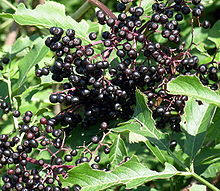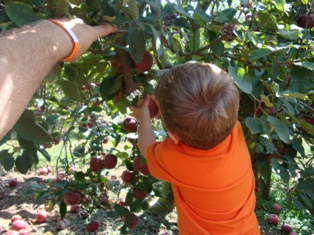
Looking for Elderberries - Recipes, Nutritional Information, Home Canning and Freezing Instructions! in 2025? Scroll down this page and follow the links. And if you bring home some fruit or vegetables and want to can, freeze, make jam, salsa or pickles, see this page for simple, reliable, illustrated canning, freezing or preserving directions. There are plenty of other related resources, click on the resources dropdown above. If you are having a hard time finding canning lids, I've used these, and they're a great price & ship in 2 days.
If you have questions or feedback, please let me know! There are affiliate links on this page. Read our disclosure policy to learn more.
Elderberries - Recipes, Nutritional Information, Home Canning and Freezing Instructions!
Elderberries - Recipes, Nutritional Information, Home Canning and Freezing Instructions!

Elderberries and a unique American fruit, familiar to native Americans, but still not commonly known by many others. Ripe elderberries yield an abundance of sweet juice that is used for jelly, jam, juice, elderberry wine and syrups. They can be cooked into a rich sauce that needs no sweetening. The whole berries are very tart and seedy, but still make excellent pies.
Elderberries usually ripen throughout the months of August to October, depending upon the weather and area of the country. The clusters of berries are gathered in large quantities. We will only use the dark purple berries (read below).
There are seven native species, two of which are shrub-like (small tree) and found in eastern North America, the others spread across the west. Utah State University tells us that "native Americans had a use for almost all parts of this plant; berries for food (fresh or dried); stems for tubes, pipes and musical instruments. The USDA says "Only the blue or purple berries of elderberry are edible. The active alkaloids in elderberry plants are hydrocyanic acid and sambucine. Both alkaloids will cause nausea so care should be observed with this plant. Elderberries are high in Vitamin C. The red berries of other species are toxic and should not be gathered". Cornell University reminds us that "Uncooked berries have a dark purple juice and are astringent and inedible". Some Indians called this plant "the tree of music," since the smaller twigs and limbs made excellent flutes. Strips from larger limbs made arrow shafts. Flowers were used for external antiseptic washes."
Even animals appreciate the elderberry: deer and elk browse heavily on the leaves and twigs. Birds enjoy the berries
If you'd like to make some elderberry foods, see these pages for directions:
- Canning elderberries
- Canning elderberry juice
- Freezing elderberries
- Elderberry pie
- Juicers make the job a lot easier!
Nutritional Information for Elderberries:
per 100 gm /approximately cup of berries
-
Calories: 73
-
Potassium: 280 mg
-
Carbohydrates: 18.4 gm
-
Ascorbic Acid: 36 mg
-
Fiber: 7 mg
-
Vitamin A: 300 IU (60 R.E.)
- Smaller amounts of calcium, iron, phosphorus and the B Vitamins.
Freezing Elderberries
Wash the elderberries in a colander under cold running water, removing any mushy or spoiled berries. Allow the water to drain off for a few minutes.
You can then freeze them using either of these methods:
Dry pack, with no added sugar.
Pack the berries into freezer containers, such as ziploc bags, then exclude as much air as you can (Vacuum sealers work great) then seal and freeze. This method works best when you plan to later use the berries in cooked dishes and pies.
Wet pack, in a sugar syrup.
-
Make a medium sugar syrup by dissolving 3 cups of sugar in 4 cups of warm water, to yield 51/2 cups of syrup. Chill in the fridge for a couple of hours before using.
-
Pack the berries into freezer containers, such as ziploc bags, then cover them with the syrup.
-
Exclude as much air as you can (Vacuum sealers work great, after you freeze the bags first, then vacuum seal them in a frozen state) then seal and freeze.
Picking Tips
[General picking tips and a guide to each fruit and vegetable] [How
much do I need to pick?
(Yields - how much raw makes how much cooked or frozen)] [Selecting
the right varieties to pick] [All
about apple varieties - which to pick and why!] [Picking tips for Vegetables]
[ Strawberry picking tips]
[ Blueberries picking tips]

Illustrated Canning, Freezing, Jam Instructions and Recipes
[ Easy Home Canning Directions] [FAQs - Answers to common questions and problems] [Recommended books about home canning, jam making, drying and preserving!] [Free canning publications to download and print]
Looking for canning equipment and supplies?
Water bath canner with a jar rack
Pressure canners for gas, electric and induction stoves: Presto 23Qt or T-fal 22Qt
Canning scoop (this one is PERFECT)
Ball Blue book (most recent version)
Jars: 8oz canning jars for jams
Find Other types of farms:
Farm markets and roadside stands
Road trips and camping resources
Local Honey, apiaries, beekeepers
Consumer fraud and scams information
Home canning supplies at the best prices on the internet!
Maple Syrup Farms, sugarworks, maple syrup festivals
Environmental information and resources
Farms For Your Event for birthday parties, weddings, receptions, business meetings, retreats, etc.
Festivals - local fruit and vegetable festivals
Get the
most recent version of
the Ball Blue Book
With this Presto 23 quart pressure canner and pressure cooker, you can "can" everything, fruits, vegetables, jams, jellies, salsa, applesauce, pickles, even meats, soups, stews. Model 01781

You can make jams, jellies, can fruit, applesauce, salsa and pickles with water bath canners, like this Granite Ware 12-Piece Canner Kit, Jar Rack, Blancher, Colander and 5 piece Canning Tool Set

